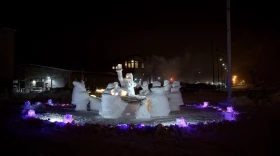While President Trump has framed the pipeline as a centerpiece to his plans for “unleashing” the country’s energy, there are many questions surrounding the mega project.
Latest News & Local Programs
-
Anchorage Fire Department officials say they received a report of the fire at around 5 a.m. Wednesday morning at a Dimond Estates mobile home. One person was found dead inside.
-
The governor announced the appointment of Wasilla resident Steve St. Clair and Sutton resident Garret Nelson to the state House of Representatives.
-
Celebrate the holiday season with special programming from Alaska Public Media.
-
State lawmakers weigh in on next month's legislative session. We discuss what to expect.
-
There’s a lot to discuss in the next session, from a possible gas pipeline to Gov. Mike Dunleavy’s promise to deliver a plan to stabilize the state’s finances.
-
From Utqiaġvik to Petersburg, communities find unique ways to bring joy at the darkest time of the year.
-
Playing the State Office Building's rare organ, T.J. Duffy said goodbye to a packed audience filled with longtime listeners.
-
The SAVE Plan is ending, and repayment options will change dramatically in the new year.
-
Could a diesel-electric hybrid fishing boat push the industry to go green?
-
Author Lani Hulse published "Aanaq? Am I your sunset?" to support the Western Alaska Disaster Relief Fund.
Thanks to our sponsors
More from AKPM
Your weekly guide to the best events and happenings around town.



















